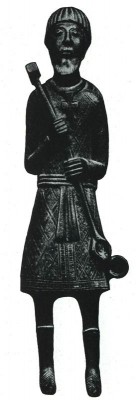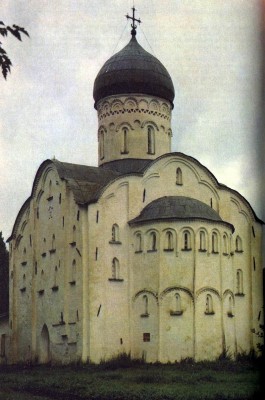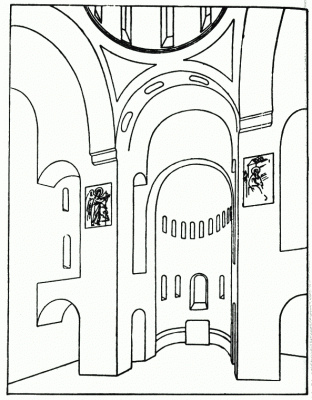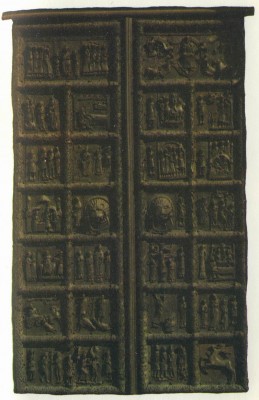The Epistle of Archbishop Basil of Novgorod to Bishop Theodore of Tver Concerning Paradise
The Epistle of Basil the pilgrim, Archbishop of Novgorod, to Bishop Theodore the Good of Tver on earthly paradise is found in The Sophia First Chronicle and The Resurrection Chronicle under the year 1347.23
Basil wrote his Epistle in Tver, after learning of the “disagreement” which had arisen among the people of Tver concerning the question of the existence of paradise. “I have heard, brother,” he addresses Theodore, “that you say ‘the paradisb in which Adam dwelt is gone’, and there is only the paradise ‘of the mind’” (i.e., that Theodore believes there is no earthly paradise, only paradise as a spiritual, moral category). Basil does not agree with this and argues the existence of earthly paradise. He bases his arguments on various texts, making extensive reference to apocryphal works and to the “testimony” of eyewitnesses.
Basil’s arguments, which seem naive to the modern reader, reveal the great respect which Old Russian writers had for the written word and also the existence in Novgorod of oral tales by sailors and travellers about distant, mysterious lands, the reality of which their audience did not doubt.
Proof that paradise exists can be found, according to Basil, in the Holy Scriptures and the writings of the Church Fathers. Nowhere is it said that earthly paradise had disappeared. It was created by God, and “all God’s works are everlasting”. This is indeed so, as Basil has seen for himself: when he was in Jerusalem, he saw with his “own eyes” fig trees planted by Jesus, which “have survived … to this very day, and not withered or rotted”. He was also a “witness”, he says, that the town gates closed by Jesus “stand unopened to this very day”. All this, Basil sincerely believes, is indisputable proof that earthly paradise exists too. There are also men who have seen the existence of both paradise and hell on earth. They are Novgorodian seafarers. “To this day,” Basil writes, “torments (i.e., hell) are to be found in the West.” “Many of my spiritual children, the people of Novgorod, have seen it in the Breathing Sea: a worm that never slumbers, and the gnashing of teeth and the seething River Morg, and the water there doth flow into the underworld and come up again three times a day.” This vivid description of the Arctic Ocean (the BreathingSea is a sea with the ebb and flow of the tide) reflects both legends of the harsh North Sea and a fantastic explanation of strange natural phenomena (the tidal ebb and flow is the water flowing in and out of the underworld). The Novgorodians are said to have seen the very spot where earthly paradise is.
In his Epistle Basil recounts the poetic legend of the earthly paradise which the Novgorodians found. Parallels to this subject can be traced in a number of other literatures, but the legend retold by Basil bears the clear imprint of local Novgorodian origin. Like the story of the BreathingSea, this legend reflects the fantastic tales of Novgorodian seafarers about their voyages. A storm carries some Novgorodians* boats far out to sea, to mountains on which, as those who took part in the voyage relate, the composition of the Deisis24 was painted “in a marvellous lazor”25 (a very precious bright blue, particularly beloved by the Novgorodians). The spot is bathed in ineffable light, and joyous singing wafts from behind the mountains. The mariners are sent up a mountain and see what lies behind them, clap their hands joyfully and run off. One of them ties a rope round his leg so he can be held back. When they drag him back to the boat, he is dead. The Novgorodians sail away from the spot in terror. Basil gives the names of those who witnessed the event and recounted it: “Moislav and Yakov”, and as proof of the truth of their story he notes that the “children and grandchildren” of Moislav and Yakov are “hale and hearty” even now.
Unlike translated works on the search for paradise on earth, which are excessively fantastic, everything in Basil’s Epistle is simpler, more life-like and more “authentic”. Basil is not only arguing the correctness of his philosophical and theological views on the existence of a paradise on earth but also telling an interesting story. One can sense a local patriotism in it for it is not about apocryphal heroes of the distant past from foreign lands, but about Novgorodians who discover an earthly paradise, and whose children and grandchildren are still alive.
In respect of both genre and subject-matter the literature of the first three quarters of the fourteenth century continues the traditions of the preceding period. New centres of chronicle- writing arose, vitae were compiled, epistles and homilies written, and foreign works translated.
In this period the chronicle-writing of Tver and Pskov, which began in the late thirteenth century, continued to develop. Moscow chronicle-writing emerged and, with the growth and enhancement of Moscow’s political power, acquired a national Russian character. The year 1305 saw the compilation of a chronicle that was to provide the basis in all subsequent chronicle-writing for an account of the history of Russia from earliest times to the beginning of the fourteenth century.
The vitae which can be dated to the beginning or first half of the fourteenth century continue the old traditions of the genre for the most part, but a strengthening of the political and publicistic elements can be detected. The Life of Metropolitan Peter is acutely political. In The Tale of Michael of Tver, Son of Yaroslav, the civic element is enhanced in the Life of the martyr prince. The traditions of the heroic type of princely vita acquire a local character in The Tale of Dovmont and are simplified to some extent.
The Mongol overlordship oppressing the Russian people determined the choice of translated works that circulated during this period in Russia. There was a heightened interest in eschatological writings and works about happy, prosperous lands and the search for paradise on earth. The latter theme became the subject of an original Russian work, the Epistle of Archbishop Basil of Novgorod. However, not only despair and hopeless dreams of wondrous lands and an earthly paradise filled the minds of the people of this age. The Tale of Dovmont extols heroism, and The Tale of Shevkal tells of the people’s struggle against their Mongol overlords.
In the period in question we can detect the interaction, not very significant, but increasing nevertheless, of literature with local, originally oral traditions and the growth of democratic elements in literature. This is seen in the character of Pskov chronicle-writing and in the special features of The Tale of Dovmont. Sympathy with the outlook of the popular masses can be seen in The Tale of Shevkal. Basil’s Epistle, although written on a universal subject, bears a clearly expressed local, Novgorodian stamp and reveals the author’s interest in Novgorodian folk legends.
The style of monumental historicism did not undergo any significant changes in this period, compared with the preceding one. Nevertheless this style was becoming less elevated, to some extent simpler and more “down to earth”. As already mentioned, the features of a new style developed gradually in Old Russian literature, within the old style. The first three quarters of the fourteenth century were precisely such a period of transition. This time saw the gradual maturing of the prerequisites for the expressive-emotional style that replaced monumental historicism and characterised the following stage in the history of Old Russian literature.

Self-portrait of the master Avraam. Detail of the Korsun Doors in the Cathedral St Sophia in Novgorod
 History of Russian Literature
History of Russian Literature



